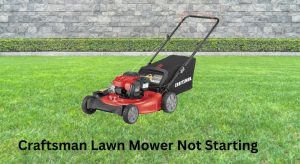It’s mowing day, but your Craftsman riding lawn mower will not turn over—no click, no crank, just silence or maybe a faint click from under the seat. Frustrating, right? The quickest fix is often a weak battery or a safety switch issue. Start by checking the battery voltage (should be 12.4–12.8V) and ensure the brake pedal is fully depressed and the PTO/blade switch is off. These simple checks solve a surprising number of no-crank issues in minutes.
If that quick fix didn’t do it, don’t worry. In this comprehensive guide, you’ll learn the most common causes of a Craftsman riding mower not turning over and how to fix each one step-by-step: battery and cable problems, blown fuses, faulty ignition switches, bad solenoids, seized starters, safety interlock failures, and even engine hydrolock. By the end, you’ll have a reliable method to diagnose and restore your mower to starting normally.
Common Causes of a Craftsman Riding Lawn Mower Not Turning Over

- Dead or weak battery (below ~12.2V)
- Corroded or loose battery cables/grounds
- Blown fuse or tripped circuit protector
- Faulty ignition switch
- Bad starter solenoid (clicking but no crank)
- Failed starter motor
- Safety interlock switch failure (seat, brake, PTO)
- PTO engaged or brake not pressed
- Neutral switch/shifter not in neutral
- Corroded wiring or poor ground to frame/engine
- Hydrolocked engine (fuel or oil in cylinder)
- Seized engine (lack of oil or mechanical failure)
How to Fix a Craftsman Mower That Won’t Turn Over

Work from the simplest, fastest checks to more advanced repairs. Always observe safety precautions.
Important: Remove the key, set the parking brake, and disconnect the negative battery cable when working on electrical connections. Keep hands clear of belts and blades.
Method 1: Quick Checks and Battery Basics
Diagnosing the Issue
- Symptom: No sound at all when turning the key.
- Likely: Dead battery, bad ground, blown fuse, safety switch.
- Tools: Multimeter, 10mm/13mm wrench, wire brush.
Fix Steps
-
Verify safety positions
– Ensure PTO/blade switch is OFF.
– Press brake/clutch pedal fully.
– Set gear selector to Neutral.
– Sit on seat (some models require operator presence). -
Check battery voltage
– Set multimeter to DC volts.
– A healthy, charged 12V battery should read 12.4–12.8V.
– 12.2V = ~50% charge; below 12.0V likely won’t crank. -
Charge or jump the battery
– Charge at 2–10A for 2–6 hours until 12.6–12.8V.
– If jumping: Use a known good 12V source. Connect positive to positive, negative to mower frame ground, not battery negative.
– Try to start. If it cranks with a jump, battery may be failing or not charging. -
Inspect and clean battery terminals and grounds
– Remove negative, then positive cable.
– Clean posts and cable ends with a wire brush/baking soda solution.
– Check for frayed or green corrosion under insulation.
– Reinstall positive first, then negative. Tighten securely—no wiggle. -
Check main ground and engine ground strap
– Trace the negative cable to where it bolts to the frame/engine.
– Remove bolt, sand to bare metal, reinstall tightly.
Testing
- Turn the key. If it cranks, you fixed it.
- If still no crank, proceed to Method 2.
Method 2: Fuse, Ignition Switch, and Interlock Safety System
Diagnosing the Issue
- Symptom: No crank; sometimes lights work.
- Likely: Blown fuse, bad ignition switch, open safety switch.
- Tools: Multimeter/continuity tester, spare fuses (typically 15–20A mini or blade).
Fix Steps
-
Locate and inspect the fuse
– Look near the battery or under the seat/dash wire harness.
– Pull the fuse; check visually and with a meter.
– Replace with same amperage. If it blows again, look for chafed wires shorting to frame. -
Test the ignition switch
– Remove the connector from the back of the ignition switch.
– With the key in START, check for continuity between B (battery) and S (start) terminals.
– No continuity in START means the switch is bad. Replace with a Craftsman-compatible part. -
Verify safety interlock switches
– Seat switch: With you on the seat, it should close the circuit. Bypass only for testing by keeping seated or using a jumper temporarily. Do not operate bypassed.
– Brake/clutch switch: Requires pedal fully depressed to crank; test continuity when pressed.
– PTO switch: Must be OFF; test the switch for stuck contacts.
– Neutral switch (if equipped): Ensure lever is truly in neutral; test continuity in neutral position.
Important: Never permanently bypass safety switches. They prevent injury and blade engagement during starting.
Testing
- Try starting after each fix. If you hear a single click now, move to the solenoid and starter checks.
Method 3: Solenoid and Starter Diagnostics
Diagnosing the Issue
- Symptom: Single click or rapid clicking when turning the key; no engine rotation.
- Likely: Weak battery under load, bad solenoid contacts, or failing starter.
- Tools: Multimeter, jumper wire, insulated pliers, 13mm wrench.
Fix Steps
-
Perform a load test
– Measure battery voltage while turning the key to START.
– If it drops below ~10.5V, the battery is weak even if it read 12.6V at rest. Replace the battery (typical size U1-230–300 CCA). -
Check solenoid trigger voltage
– Identify the small solenoid terminal (S).
– With key in START, you should see ~12V at the S terminal.
– If no 12V, the issue is upstream (ignition/safety circuit). Recheck Method 2. -
Bypass the solenoid for testing
– Warning: Sparks possible. Ensure PTO off, brake on, blades disengaged.
– Use an insulated screwdriver to briefly bridge the two large solenoid posts.
– If the engine cranks, the solenoid is bad—replace it.
– If it still doesn’t crank, suspect the starter or cable/ground issue. -
Bench-test the starter (if accessible)
– Remove the starter (usually 2 bolts near flywheel).
– Apply 12V positive to the starter post and negative to the starter body.
– The pinion should spin strongly. If weak or dead, replace the starter. -
Inspect the starter gear and flywheel teeth
– Check for stripped/broken teeth or a stuck Bendix gear.
– Clean debris; lightly lube the Bendix shaft with dry lube (avoid heavy grease).
Testing
- After replacing a solenoid or starter, ensure all grounds/cables are tight and try starting again.
Method 4: Engine-Related No-Crank (Hydrolock, Seizure, Mechanical)
Diagnosing the Issue
- Symptom: Starter tries but can’t turn engine, or engine is locked solid with a thud.
- Likely: Hydrolock from fuel/oil in cylinder, or seized engine.
- Tools: Spark plug socket, rag, spark tester, hand tools.
Fix Steps
-
Check for hydrolock
– Remove the spark plug(s).
– Try turning the key or rotate the engine by hand with a socket on the crank pulley.
– If fluid sprays out of the spark plug hole, you found hydrolock.
– Crank briefly to expel fluid. Then:- If it’s fuel: Inspect carburetor needle/seat and fuel shutoff solenoid. Replace needle, add inline fuel shutoff valve, turn off when stored.
- If it’s oil: Overfilled crankcase or mower tipped—drain to proper level.
-
Verify engine rotates freely
– With plug(s) out, the engine should spin easily.
– If it’s still locked, check for a stuck blade, debris in deck, or seized PTO clutch (remove belt to isolate engine).
– If engine remains seized with belts off, internal damage may have occurred—professional service required. -
Compression check (optional)
– While not a cause of no-crank, low compression hints at valve issues that can increase starting load. Adjust valves to spec if needed (usually 0.004–0.006″ intake/exhaust on many Briggs engines). Refer to your engine model numbers.
Testing
- Reinstall new spark plug(s), ensure correct oil level and fresh fuel. Try starting again.
How to Prevent Future Starting Issues
- Keep battery on a smart maintainer when stored to prevent sulfation.
- Clean and tighten battery cables and grounds every season.
- Replace the fuel filter annually; use fresh fuel with stabilizer if storing >30 days.
- Store mower under cover; moisture accelerates corrosion in electrical connectors.
- Inspect wiring harnesses near the frame and engine for chafing; loom and secure.
- Exercise the mower monthly during off-season to keep the charging system active.
Pro Tips
- Use dielectric grease on battery terminals and electrical connectors to prevent corrosion.
- Upgrade to a higher CCA U1 battery if you mow in cold climates or have a twin-cylinder engine.
- Label safety switch connectors during inspection to avoid cross-connection.
- If fuses blow repeatedly, look around the steering column and frame pinch points for a rubbed-through wire.
- Check the voltage at the battery with the engine running: 13.2–14.5V indicates the alternator/rectifier is charging. Below 13V means charging system service is needed.
- Keep the PTO switch clean; dust and grass fines can cause intermittent no-crank.
- Replace the ignition key switch with an OEM or quality aftermarket compatible with your Craftsman model—cheap switches often fail early.
When to Call a Professional
- You smell burning insulation, see melted connectors, or have repeated fuse blowing—risk of short circuits.
- Engine will not rotate even with spark plugs removed and belts off—possible internal seizure.
- You lack spark and no crank simultaneously, indicating deeper wiring or module issues.
- Charging system tests show low voltage despite a new battery—rectifier/stator diagnosis needed.
- You’re not comfortable bypass testing the solenoid/starter safely.
Typical costs:
– Battery: $35–$80 (U1 type, 200–350 CCA)
– Solenoid: $15–$30
– Starter motor: $60–$180
– Ignition switch: $20–$50
– Shop diagnostic: $60–$120; labor $80–$120/hr depending on region
Warranty notes:
– Check your Craftsman warranty or extended protection plan before replacing major parts.
– Keep receipts and note model/serial numbers (under seat or frame).
FAQ
Q: What does it mean if my Craftsman mower just clicks once and won’t turn over?
A: A single click usually points to a weak battery, corroded terminals, or a failing solenoid. Load-test the battery (should stay above ~10.5V during crank), clean/tighten cables, and if you get 12V to the solenoid’s small terminal in START but no crank, replace the solenoid.
Q: How many volts should my mower battery have?
A: At rest, a healthy 12V battery should read 12.4–12.8V. During cranking, it shouldn’t drop below about 10.5V. With the engine running, 13.2–14.5V shows proper charging.
Q: Can a bad seat switch prevent the mower from turning over?
A: Yes. Many Craftsman models require the seat occupied and the brake depressed to crank. A faulty or unplugged seat switch can interrupt the starter circuit. Test with a meter for continuity when seated.
Q: Where is the fuse located on Craftsman riding mowers?
A: Commonly near the battery under the seat, alongside the wiring harness, or behind the dash. It’s usually a 15–20A blade/mini blade fuse in a small holder.
Q: How do I tell if the starter is bad vs. the solenoid?
A: If bridging the solenoid’s large posts makes the engine crank, the solenoid is bad. If bridging doesn’t crank, but you have battery power and good grounds, the starter or starter cable is likely bad. Bench-test the starter with a 12V source.
Q: What is hydrolock and how do I fix it?
A: Hydrolock is when fuel or oil fills the cylinder, preventing the piston from moving. Remove the spark plug(s) and crank to expel fluid, correct the cause (stuck carb needle, overfilled oil), then reinstall plugs and try again.
Q: My battery is new but it still won’t turn over. Why?
A: Check for poor ground, loose cables, blown fuse, or a bad safety switch. Also confirm the charging system; a non-charging mower will drain even a new battery quickly between uses.
Alternative Solutions
If repeated electrical failures or costly part replacements persist, you may consider these options.
| Solution | Pros | Cons | Best For |
|---|---|---|---|
| Replace key components (battery, solenoid, starter) | Restores reliability; parts widely available | Cost adds up if misdiagnosed | Owners with basic tools |
| Professional diagnostic/service | Fast, accurate troubleshooting | Labor cost | Complex electrical issues |
| Upgrade to AGM U1 battery | Better cranking, vibration-resistant | Higher upfront cost | Cold climates, twin engines |
| Sell/replace with newer mower | New warranty, improved safety | Highest cost | Older units with multiple failures |
Get Your Craftsman Mower Working Again
By following this guide, you now have a clear, step-by-step plan to fix a Craftsman riding lawn mower that will not turn over:
– Quick fixes: battery charge/load test, cable/ground cleaning, safety positions
– Electrical checks: fuse, ignition switch, safety interlocks
– Cranking system: solenoid and starter diagnostics and replacements
– Engine issues: hydrolock and mechanical lockup checks
– Preventive care to avoid future no-crank problems
Start with the simple checks—they solve most cases in minutes. With a multimeter, a few basic tools, and these methods, you’ll have your Craftsman turning over and running reliably again.
Have you solved your starting issue? Share what worked for your model in the comments to help other readers. Found this helpful? Bookmark it for quick reference before your next mow.




